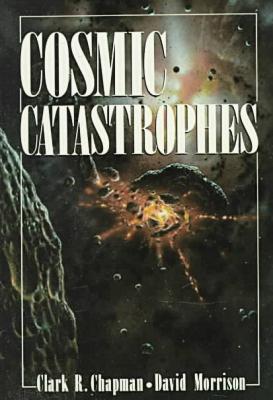

| COSMIC CATASTROPHES Clark R. Chapman David Morrison New York: Plenum Press, 1989 |
Rating: 5.0 High |
|||
| ISBN-13 978-0-306-43163-0 | ||||
| ISBN 0-306-43163-7 | 302pp. | HC/BWI | $? | |
| CHAPTER 1. PROLOGUE: DANGER FROM THE SKIES | ? |
| CHAPTER 2. IMPACTS ON THE EARTH | ? |
| CHAPTER 3. UNIFORMITARIANISM AND CATASTROPHISM | ? |
| CHAPTER 4. CRATERS ON THE MOON AND MARS | ? |
| CHAPTER 5. INTERPLANETARY PROJECTILES: ASTEROIDS AND COMETS | ? |
| CHAPTER 6. DEATH OF THE DINOSAURS | ? |
| CHAPTER 7. DEATH STARS AND COMET SHOWERS | ? |
| CHAPTER 8. NUCLEAR WINTER | ? |
| CHAPTER 9. VIOLENT VOLCANOES AND MANGLED MOONS | ? |
| CHAPTER 10. CHAOS | ? |
| CHAPTER 11. ORIGIN OF THE MOON | ? |
| CHAPTER 12. COLLIDING WORLDS | ? |
| CHAPTER 13. CATASTROPHISM GONE WILD: THE CASE OF IMMANUEL VELIKOVSKY | ? |
| CHAPTER 14. OTHER FRINGE CATASTROPHISM | ? |
| CHAPTER 15. CLIMATES GONE WRONG: VENUS AND MARS | ? |
| CHAPTER 16. THE GREENHOUSE EFFECT AND OZONE HOLES | ? |
| CHAPTER 17. DEATH OF THE SUN | ? |
| CHAPTER 18. SUPERNOVAS: NATURE'S MOST VIOLENT CATASTROPHES | ? |
| CHAPTER 19. THREAT FROM THE SKIES: WILL A COMET STRIKE? | ? |
As you can see from the table of contents, this book ranges widely, covering just about every form of catastrophe. Unlike some scare-mongering tomes published about the same time, this one avoids a sensational tone. At the same time it does not wave away the very real (though not imminent) threat from comets and asteroids. The authors1 point out that very little money would be required for a good first step in dealing with the problem: identifying the Earth-crossing asteroids and plotting their paths. It could be done with a medium-sized, dedicated telescope or two (one in each hemisphere) and the number of people who staff a typical McDonalds restaurant. (This would at least double the staff currently working on such identification.)
Despite the authors' justifiable frustration with the lack of high-level attention to the asteroid threat, they have put together a well-balanced assessment of that threat as well as many others. Anyone who reads it (and it reads easily) will find the irrational fears they might have swept away, and will come away with a mild but valuable sense of outrage.
As the authors say on page 38:
In the future, we must continue to avoid the trap of ascribing to Nature the simple, orderly behavior that we find easier to calculate and more agreeable to think about. |
Along with this sensible warning, you will find a good discussion of the evolution of scientific understanding from uniformitarianism to catastrophism, with side trips into some popular pseudo-scientific theories, as well as accounts of the unravelling of mysteries like how the sun shines.
I detected no mis-statements of fact and only a few typos:
| Page 101: | "The illustration shows how well the 8 major extinctions match the 26-year interval." |
| S/B "26-million year". |
| Page 134: | "The grooves in its surface may have resulted from fracturing by the large impact crater, perhaps enchanced by tidal forces..." |
| S/B "enhanced". |
| Page 261: | "It is extremely dense; a teaspoon would weigh a ton." |
| S/B "teaspoonful". |
| Page 266: | "It was astronomers at Cerro Tololo and another southern observatory, Las Campanãs, ..." |
| Has the tilde on the wrong letter; S/B "Campañas". |

 To contact Chris Winter, send email to this address.
To contact Chris Winter, send email to this address.